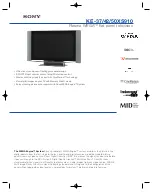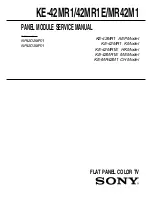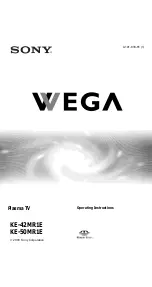
Annex 3 - Philips TV - Digital camera and USB issues
EN
57
Notes:
- the latest version of this document can be found on the Philips support website
(www.philips.com/support);
- the software of your TV is upgradeable. If you have problems first check if you have the latest
software installed on your TV. The latest software, together with instructions, can be found on the
Philips support website. Use the type number of your TV to find this documentation and other
related files.
- Philips can’t be held responsible neither for any errors in the content of this document nor for any
problems as a result of the content in this document. Errors reported to Philips will be adapted
and published on the Philips support website as soon as possible.
Digital Camera Issues
If a USB connection between your digital camera and the TV isn’t working, you can try the
solutions below to resolve your problem.
<
Make sure your digital camera is switched on and verify if the configuration of your digital camera
is correct (see the manual of your digital camera for more information).
<
Some digital cameras allow you to switch off the USB interface. Make sure that the USB interface
is switched on before connecting to the TV.
<
If you have a digital camera with only internal memory (no removable memory) you can try to
copy the content manually to a USB memory device using a personal computer.
<
Some digital cameras allow you to switch between PTP (Picture Transfer Protocol) or “PC Link”
and USB Mass Storage. Make sure that you select USB Mass Storage or “PC Drive” on your digital
camera.
<
If your camera supports different interface settings be sure to try them one by one or contact the
reseller of your camera to find out the correct setting.
USB Memory Device Issues
<
Devices connected to the USB port of your TV must be “Mass Storage Class” compliant. If your
device (digital camera. MP3 player, portable harddisk, …) is not “Mass Storage Class” compliant it
will not be detected by the content browser of the TV.
<
The following subsets of the Mass Storage Class specification are supported:
The implementation of the TV is based on the “Universal Serial Bus Mass Storage Class
Specification Overview” (v1.2, June 23, 2003) including all documents referenced by the
document. The document can be found on the USB standardization website (www.usb.org).
Full support of the USB Mass Storage Class Bulk-Only Transport (bInterfaceProtocol = 50h).
Full support of SubClass Code = 05h; SFF-8070i spec.
Full support of SubClass Code = 06h; SCSI transparent command set.
<
For large USB memory devices, when you are in the Content Browser, it may take a long time
before you can access your files.
<
When using a USB portable harddisk: Due to the high power consumption of the harddisk, it is
advised to use the external power supply of the portable harddisk to guarantee proper working
under all conditions.






































